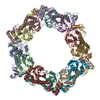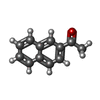[English] 日本語
 Yorodumi
Yorodumi- PDB-8hla: Heteromeric ring comprised of peroxiredoxin from Thermococcus kod... -
+ Open data
Open data
- Basic information
Basic information
| Entry | Database: PDB / ID: 8hla | ||||||
|---|---|---|---|---|---|---|---|
| Title | Heteromeric ring comprised of peroxiredoxin from Thermococcus kodakaraensis (TkPrx) F42C/C46S/C205S/C211S mutant modified with 2-(bromoacetyl)naphthalene (Naph@TkPrx*F42C) and TkPrx C46S/F76C/C205S/C211S mutant modified with 2-(bromoacetyl)naphthalene (Naph@TkPrx*F76C) (Naph@(MIX|3:3)) | ||||||
 Components Components | (Peroxiredoxin) x 2 | ||||||
 Keywords Keywords | OXIDOREDUCTASE / Peroxiredoxin / Complex / Protein protein interactions | ||||||
| Function / homology |  Function and homology information Function and homology informationthioredoxin-dependent peroxiredoxin activity / thioredoxin-dependent peroxiredoxin / cell redox homeostasis / peroxidase activity / cytosol Similarity search - Function | ||||||
| Biological species |   Thermococcus kodakarensis KOD1 (archaea) Thermococcus kodakarensis KOD1 (archaea) | ||||||
| Method | ELECTRON MICROSCOPY / single particle reconstruction / cryo EM / Resolution: 2.81 Å | ||||||
 Authors Authors | Himiyama, T. / Hamaguchi, T. / Yonekura, K. / Nakamura, T. | ||||||
| Funding support |  Japan, 1items Japan, 1items
| ||||||
 Citation Citation |  Journal: Bioconjug Chem / Year: 2023 Journal: Bioconjug Chem / Year: 2023Title: Unnaturally Distorted Hexagonal Protein Ring Alternatingly Reorganized from Two Distinct Chemically Modified Proteins. Authors: Tomoki Himiyama / Tasuku Hamaguchi / Koji Yonekura / Tsutomu Nakamura /  Abstract: In this study, we constructed a semiartificial protein assembly of alternating ring type, which was modified from the natural assembly state via incorporation of a synthetic component at the protein ...In this study, we constructed a semiartificial protein assembly of alternating ring type, which was modified from the natural assembly state via incorporation of a synthetic component at the protein interface. For the redesign of a natural protein assembly, a scrap-and-build approach employing chemical modification was used. Two different protein dimer units were designed based on peroxiredoxin from , which originally forms a dodecameric hexagonal ring with six homodimers. The two dimeric mutants were reorganized into a ring by reconstructing the protein-protein interactions via synthetic naphthalene moieties introduced by chemical modification. Cryo-electron microscopy revealed the formation of a uniquely shaped dodecameric hexagonal protein ring with broken symmetry, distorted from the regular hexagon of the wild-type protein. The artificially installed naphthalene moieties were arranged at the interfaces of dimer units, forming two distinct protein-protein interactions, one of which is highly unnatural. This study deciphered the potential of the chemical modification technique that constructs semiartificial protein structures and assembly hardly accessible by conventional amino acid mutations. | ||||||
| History |
|
- Structure visualization
Structure visualization
| Structure viewer | Molecule:  Molmil Molmil Jmol/JSmol Jmol/JSmol |
|---|
- Downloads & links
Downloads & links
- Download
Download
| PDBx/mmCIF format |  8hla.cif.gz 8hla.cif.gz | 446.7 KB | Display |  PDBx/mmCIF format PDBx/mmCIF format |
|---|---|---|---|---|
| PDB format |  pdb8hla.ent.gz pdb8hla.ent.gz | 374.3 KB | Display |  PDB format PDB format |
| PDBx/mmJSON format |  8hla.json.gz 8hla.json.gz | Tree view |  PDBx/mmJSON format PDBx/mmJSON format | |
| Others |  Other downloads Other downloads |
-Validation report
| Summary document |  8hla_validation.pdf.gz 8hla_validation.pdf.gz | 1.6 MB | Display |  wwPDB validaton report wwPDB validaton report |
|---|---|---|---|---|
| Full document |  8hla_full_validation.pdf.gz 8hla_full_validation.pdf.gz | 1.7 MB | Display | |
| Data in XML |  8hla_validation.xml.gz 8hla_validation.xml.gz | 92.6 KB | Display | |
| Data in CIF |  8hla_validation.cif.gz 8hla_validation.cif.gz | 137.5 KB | Display | |
| Arichive directory |  https://data.pdbj.org/pub/pdb/validation_reports/hl/8hla https://data.pdbj.org/pub/pdb/validation_reports/hl/8hla ftp://data.pdbj.org/pub/pdb/validation_reports/hl/8hla ftp://data.pdbj.org/pub/pdb/validation_reports/hl/8hla | HTTPS FTP |
-Related structure data
| Related structure data |  34859MC  8hh0C C: citing same article ( M: map data used to model this data |
|---|---|
| Similar structure data | Similarity search - Function & homology  F&H Search F&H Search |
- Links
Links
- Assembly
Assembly
| Deposited unit | 
|
|---|---|
| 1 |
|
- Components
Components
| #1: Protein | Mass: 24585.141 Da / Num. of mol.: 6 / Mutation: C46S,F76C,C205S,C211S Source method: isolated from a genetically manipulated source Source: (gene. exp.)   Thermococcus kodakarensis KOD1 (archaea) Thermococcus kodakarensis KOD1 (archaea)Gene: TK0537 / Production host:  References: UniProt: Q5JF30, thioredoxin-dependent peroxiredoxin #2: Protein | Mass: 24585.143 Da / Num. of mol.: 6 / Mutation: F42C,C46S,C205S,C211S Source method: isolated from a genetically manipulated source Source: (gene. exp.)   Thermococcus kodakarensis KOD1 (archaea) Thermococcus kodakarensis KOD1 (archaea)Gene: TK0537 / Production host:  References: UniProt: Q5JF30, thioredoxin-dependent peroxiredoxin #3: Chemical | ChemComp-FL3 / Has ligand of interest | Y | Has protein modification | Y | |
|---|
-Experimental details
-Experiment
| Experiment | Method: ELECTRON MICROSCOPY |
|---|---|
| EM experiment | Aggregation state: PARTICLE / 3D reconstruction method: single particle reconstruction |
- Sample preparation
Sample preparation
| Component | Name: Naph@MIX / Type: COMPLEX / Entity ID: #1-#2 / Source: RECOMBINANT |
|---|---|
| Source (natural) | Organism:   Thermococcus kodakarensis KOD1 (archaea) Thermococcus kodakarensis KOD1 (archaea) |
| Source (recombinant) | Organism:  |
| Buffer solution | pH: 8 |
| Specimen | Conc.: 6 mg/ml / Embedding applied: NO / Shadowing applied: NO / Staining applied: NO / Vitrification applied: YES |
| Specimen support | Grid material: COPPER / Grid mesh size: 200 divisions/in. / Grid type: Quantifoil R0.6/1 |
| Vitrification | Instrument: FEI VITROBOT MARK IV / Cryogen name: ETHANE / Humidity: 99 % / Chamber temperature: 277 K |
- Electron microscopy imaging
Electron microscopy imaging
| Microscopy | Model: JEOL CRYO ARM 300 |
|---|---|
| Electron gun | Electron source:  FIELD EMISSION GUN / Accelerating voltage: 300 kV / Illumination mode: FLOOD BEAM FIELD EMISSION GUN / Accelerating voltage: 300 kV / Illumination mode: FLOOD BEAM |
| Electron lens | Mode: BRIGHT FIELD / Nominal magnification: 60000 X / Nominal defocus max: 1800 nm / Nominal defocus min: 1000 nm / Cs: 2.7 mm / Alignment procedure: COMA FREE |
| Specimen holder | Cryogen: NITROGEN / Specimen holder model: JEOL CRYOSPECPORTER / Temperature (min): 89 K |
| Image recording | Electron dose: 40 e/Å2 / Film or detector model: GATAN K3 (6k x 4k) |
| EM imaging optics | Energyfilter name: In-column Omega Filter |
| Image scans | Width: 5760 / Height: 4092 |
- Processing
Processing
| Software | Name: PHENIX / Version: 1.18.2_3874: / Classification: refinement | ||||||||||||||||||||||||
|---|---|---|---|---|---|---|---|---|---|---|---|---|---|---|---|---|---|---|---|---|---|---|---|---|---|
| EM software | Name: PHENIX / Category: model refinement | ||||||||||||||||||||||||
| CTF correction | Type: NONE | ||||||||||||||||||||||||
| 3D reconstruction | Resolution: 2.81 Å / Resolution method: FSC 0.143 CUT-OFF / Num. of particles: 599283 / Symmetry type: POINT | ||||||||||||||||||||||||
| Refine LS restraints |
|
 Movie
Movie Controller
Controller


 PDBj
PDBj

